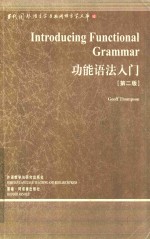

功能法语入门=introducing functional grammarPDF电子书下载
- 电子书积分:20 积分如何计算积分?
- 作 者:
- 出 版 社:
- 出版年份:2222
- ISBN:
- 页数:0 页
1 The purposes of linguistic analysis 1
1.1 Starting points 1
1.1.1 Going in through form 2
1.1.2 Going in through meaning 6
1.2 Language,context and function:a preliminary exploration 10
Exercise 12
2 Recognizing clauses and clause constituents 14
2.1 Breaking up the sentence-and labelling the parts 14
2.1.1 Recognizing constituents 15
2.1.2 Structural and functional labels 18
2.2 Ranks 21
Exercises 26
3 An overview of functional grammar 28
3.1 Three kinds ofmeaning 28
3.1.1 The three metafunctions 30
3.1.2 Three kinds of function in the clause 32
3.1.3 Three kinds of structure in the clause 34
3.1.4 Showing the options:systems networks 35
3.1.5 A fourth metafunction 38
3.2 Register and genre 39
3.2.1 Register(and the corpus) 40
3.2.2 Genre 42
Exercise 44
4 Interacting:the interpersonal metafunction 45
4.1 Introduction 45
4.2 Roles of addressers and audience 46
4.3 Mood 49
4.3.1 The structure of the Mood 49
4.3.2 Identifying Subject and Finite 50
4.3.3 Meanings of Subject and Finite 52
4.3.4 Mood in non-declarative clauses 54
4.3.5 Mood in text 58
4.3.6 The Residue 60
4.3.7 Modal Adjuncts 63
4.4 Modality 65
4.4.1 Modality and polarity 65
4.4.2 Types of modality 67
4.4.3 Modal commitment 69
4.4.4 Modal responsibility 69
4.4.5 Modality in text 72
4.5 Appraisal 75
4.6 Interaction and negotiation 79
4.7 Interaction through text 80
Exercises 83
5 Representing the world:the experiential metafunction 86
5.1 Introduction 86
5.2 Transitivity:processes and participants 88
5.2.1 Material processes 90
5.2.2 Mental processes 92
5.2.3 Relational processes 96
5.2.4 Verbal processes 100
5.2.5 Other types of process 103
5.2.6 Other participant roles 105
5.2.7 Circumstances 109
5.2.8 Transitivity in text 112
5.3 More complex aspects of transitivity 116
5.3.1 More on material processes 116
5.3.2 More on mental processes 117
5.3.3 More on relational processes 118
5.3.4 Processes in verbal group complexes 124
5.3.5 Participants in causation 125
5.4 Transitivity patterns in text 126
5.5 Ergativity 135
Exercises 138
6 Organizing the message:the textual metafunction-Theme 141
6.1 Introduction 141
6.2 Theme 142
6.3 Identifying Theme 144
6.3.1 Theme in declarative clauses 144
6.3.2 Theme in non-declarative clauses 146
6.4 Special thematic structures 149
6.4.1 Thematic equatives 149
6.4.2 Predicated Theme 151
6.4.3 Thematized comment 152
6.4.4 Preposed Theme 153
6.4.5 Passive clauses and Theme 153
6.5 Theme in clause complexes 154
6.6 Multiple Theme 156
6.6.1 Conjunctions in Theme 157
6.6.2 Conjunctive and modal Adjuncts in Theme 157
6.6.3 Textual.interpersonal and experiential elements in Theme 158
6.6.4 Interrogatives as multiple Themes 160
6.7 Some problems in Theme analysis 160
6.7.1 Existential'there'in Theme 161
6.7.2 Theme in reported clauses 161
6.7.3 Interpolations in Theme 162
6.7.4 Preposed attributives 163
6.8 Theme in text 164
6.9 A final note on identifying Theme 173
Exercises 174
7 Organizing the message:the textual metafunction-cohesion 179
7.1 Cohesion and coherence 179
7.2 Reference and ellipsis 180
7.2.1 Reference 180
7.2.2 Ellipsis 184
7.3 Conjunction 188
7.4 Cohesion in text 190
Exercise 194
8 Clauses in combination 195
8.1 Introduction 195
8.2 Units of analysis 196
8.3 Types of relations between clauses 197
8.3.1 Logical dependency relations 198
8.3.2 Logico-semantic relations 203
8.4 Expansion 204
8.4.1 Elaborating 204
8.4.2 Extending 206
8.4.3 Enhancing 207
8.5 Projection 209
8.5.1 Quotes and reports 210
8.5.2 Facts 213
8.5.3 Projection in text 215
Exercises 216
9 Grammatical metaphor 219
9.1 Introduction 219
9.2 Grammatical metaphor 220
9.3 Experiential and logical metaphors 224
9.4 Interpersonal metaphors 231
9.5 Textual metaphor 235
9.6 A cautionary note 236
Exercises 237
10 Implications and applications of functional grammar 240
10.1 Three-dimensional analysis of texts 240
10.2 A summary review of functional grammar 247
10.3 Using functional grammar 249
10.4 Closing 251
Answers to exercises 253
Further reading 283
References 288
Index 293
- 《HTML5从入门到精通 第3版》(中国)明日科技 2019
- 《少儿电子琴入门教程 双色图解版》灌木文化 2019
- 《区块链DAPP开发入门、代码实现、场景应用》李万胜著 2019
- 《Python3从入门到实战》董洪伟 2019
- 《功能涂料》刘仁主编 2018
- 《小提琴入门新教程 第3册》王中男著 2018
- 《海洋功能食品》王卉 2019
- 《小提琴入门新教程 第2册》王中男编著 2017
- 《功能食品 第2版》孟宪军 2017
- 《汉语韵律的多维特征及其认知功能》吴洁敏,朱宏达著 2019
